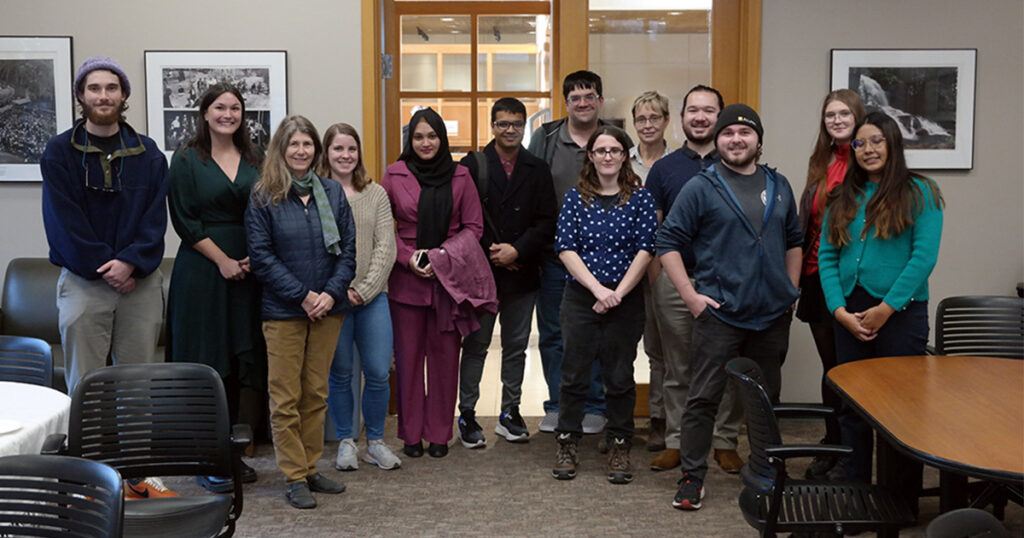Students, faculty, and judges paced along Classroom Row in Hodges Library, enjoying refreshments and admiring the framed prints on display. The art pieces were full of bold colors and evocative shapes, with titles like “Collecting Light” and “The Hidden Flower.”
To outsiders, it might look like any other art gallery.
“There is a misconception that science, technology, engineering, and math (STEM) work is only analytical,” said Sean Drewry, a PhD student in Assistant Professor Katharine Page’s lab. “In fact, there can be objective beauty in the research we do.”
Looking closer at the apparent pop art piece submitted by MSE PhD student Syeda Bushra Haider reveals that it is not just a series of recolored images, but a glimpse at how the addition of titanium can affect the microstructure of a nickel-cerium eutectic alloy.
The iris emerging from a series of multicolored dots is not a pointillist piece, but a happy surprise MSE PhD student Utkarsh Pratiush spotted while supervising a machine learning algorithm as it parsed vast volumes of microscopic data.
“This is a perfect way to showcase the beauty of science to the public while highlighting some of the exciting and interesting discoveries our researchers are making,” Drewry said.
The framed prints in the Mary Greer Room were entries in UT’s second annual Science as Art competition, which Drewry co-chaired with Kim Pestovich, a PhD student in the Scintillation Materials Research Center, and Sheryl Sanchez, a PhD student in Assistant Professor Mahshid Ahmadi’s lab. The three students are members of the UT student chapter of the Materials Research Society (MRS).
The MRS is an international professional organization dedicated to advancing technical excellence in materials science. In addition to cutting-edge speakers and demonstrations, each official MRS meeting also includes an art contest to showcase the visual beauty that emerges from its members’ research.
UT’s student chapter of MRS brought the contest to Knoxville for the first time last fall.
“Materials science brings together chemistry and physics to create new materials that can have major impacts on people’s daily lives,” Pestovich said. “Hosting this contest at UT brings attention to the interdisciplinary nature of MSE and provides students with a chance to showcase their work outside their departments.”
“I like that we are blending the science and art communities,” said Sanchez. “Each submission can bring a different and unique lens to research, showing how multifaceted science is.”
In addition to the art piece, each entrant in the contest must include a 100-word abstract explaining the relevance of the art—and the science it represents—to the general public. This is also a requirement in the official MRS competition.
“The description provides valuable context, helping viewers from any background understand the significance of the pictured work,” Sanchez said. “It also offers the researchers an opportunity to express their personal perspective on their work, whether it be emotional, philosophical, or funny.”
One of the abstracts is matter-of-fact, explaining the process of electron backscatter diffraction, while another likens the color gradients in a liquid crystal epoxy to the rainbow bridge spanning the heavens of Norse mythology.
The art pieces themselves also vary widely. There are photos at the human and microscopic scale, energy dispersive x-ray spectroscopy results, and a playfully photoshopped protein lounging on the Arctic tundra. Two submissions highlight undesirable results that the public would not normally see.
“The variety reflects how different scientists and engineers think differently about their work,” said Pestovich. “There is not just one way to be a scientist or engineer, just as there is not just one way to bring self-expression to science.”
The entered art pieces were framed and mounted courtesy of the UT MRS chapter, then displayed along Campus Row for ten days leading up to the reception in the Mary Greer Room on November 1. During that time, campus members were invited to view the gallery and cast votes for the contest’s People’s Choice Award.
At the event, entrants were available to discuss their art pieces with community members and the competition’s judges: MSE Professor Claudia Rawn, photography Professor Paul Lee from the UT School of Art, and Bryan Chakoumakos, a materials science researcher at Oak Ridge National Laboratory.
The first place award went to MSE master’s student Melanie Moczadlo; second place to MSE PhD student Cotton Pekol; and third place to nuclear engineering PhD student Hayden Sutton. All judge-selected awards included a certificate and a cash prize.
The People’s Choice Award went to the Arctic membrane protein submitted by Jake Perez, a PhD student in the Department of Earth and Planetary Sciences.
This year’s gallery included entries from four departments across both the Tickle College of Engineering and the School of Arts and Sciences. The co-chairs hope that the 2024 competition has an even broader scope, expanding the interactions between student researchers and the broader campus community.
“Researchers make contributions to society through communicating our scientific findings to the broader community,” Drewry said. “This competition is a perfect way for us to open that dialogue and showcase a different side of science, hopefully inspiring future generations to pursue STEM careers.”
All eleven entries and abstracts are still available to view in this web gallery.
Contact
Izzie Gall (865-974-7203, egall4@utk.edu)
